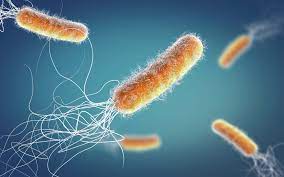Pseudomonas lalkuanensis: Difference between revisions
No edit summary |
|||
| (12 intermediate revisions by the same user not shown) | |||
| Line 1: | Line 1: | ||
{{Uncurated}} | {{Uncurated}} | ||
[[Image: | [[Image:Pseudomonas_lalkuanensis.jpg|thumb|300px|right|Pseudomonas lalkuanensis. Image credit: https://www.biomerieux-industry.com/en-us/node/771.]] | ||
| Line 23: | Line 23: | ||
|} | |} | ||
Pseudomonas lalkuanensis sp. nov. | |||
==Description and Significance== | ==Description and Significance== | ||
Pseudomonas lalkuanensis is a gram-stain-negative, rod-shaped, aerobic, oxidase-positive and catalase-positive strain, also referred to as PE08. It was first isolated from contaminated soil collected from a paper mill yard in Lalkuan, Uttarakhand, India. It is structurally similar to Pseudomonas aeruginosa, a bacteria that causes infection in the blood, lungs, or other parts of the body after surgery. | |||
==Genome Structure== | ==Genome Structure== | ||
Pseudomonas lalkuanensis was measured to be 0.25–0.45 µm wide and 0.9–1.8 µm long. Optimum growth is observed to be at 30 °C (range, 5–40 °C), with 1–2 % NaCl (range, 0–3 %) and at pH 7 (range 6–11). It is made up of a singular chromosome and a variable number of plasmids. | |||
==Cell Structure, Metabolism and Life Cycle== | ==Cell Structure, Metabolism and Life Cycle== | ||
The G+C content in the genome was 64.24 mol%. The DNA–DNA hybridization and average nucleotide identity values between strain PE08T and its closely related type strain, P. resinovorans DSM 21078T were below 34.8 % and 87.96 %, respectively. The predominant fatty acids were summed feature 8 (C18 : 1ω7c and/or C18 :1 ω6c), summed feature 3 (C16 : 1ω7c and/or C16 : 1ω6c), C16 : 0 and C12 : 0. The major polar lipids were diphosphatidylglycerol, phosphatidylglycerol and phosphatidylethanolamine. | |||
| Line 45: | Line 53: | ||
==Ecology and Pathogenesis== | ==Ecology and Pathogenesis== | ||
Pseudomonas lalkuanensis is most commonly found in soil, water, and vegetation. Pseudomonas in general is also found in the skin, throat, and stool of some humans. Pseudomonas in the soil can promote plant growth and contributes to the health of the vegetation in the environment. Pseudomonas can also cause damage to some species of plants if they are not adapted to an environment where Pseudomonas is present. | |||
Pseudomonas aeruginosa, which is structurally similar to Pseudomonas lalkuanensis, causes infection in humans, most commonly after surgery. If a patient is infected with Pseudomonas aeruginosa in their lungs, it can lead to pneumonia. This infections can usually be treated with antibiotics and are not fatal for healthy individuals. | |||
| Line 53: | Line 62: | ||
==References== | ==References== | ||
Taxonomy browser (pseudomonas lalkuanensis). National Center for Biotechnology Information. U.S. National Library of Medicine. | |||
Cafasso J. 2019. Pseudomonas infections: Symptoms, causes, and treatments. Healthline. Healthline Media. | |||
Thorat V, Kirdat K, Tiwarekar B, DaCosta E, Debbarma P, Shouche Y, Sathe S, Goel R, Lodha T, Yadav A. 2020. Pseudomonas lalkuanensis sp. nov., isolated from a | |||
bacterial consortia of contaminated soil enriched for the remediation of e-waste. International Journal of Systematic and Evolutionary Microbiology. Microbiology Society. | |||
==Author== | ==Author== | ||
Latest revision as of 23:23, 12 December 2022

Classification
Bacteria; Proteobacteria; Gammaproteobacteria; Pseudomonadales; Pseudomonadaceae; Pseudomonas
Species
|
NCBI: [1] |
Pseudomonas lalkuanensis sp. nov.
Description and Significance
Pseudomonas lalkuanensis is a gram-stain-negative, rod-shaped, aerobic, oxidase-positive and catalase-positive strain, also referred to as PE08. It was first isolated from contaminated soil collected from a paper mill yard in Lalkuan, Uttarakhand, India. It is structurally similar to Pseudomonas aeruginosa, a bacteria that causes infection in the blood, lungs, or other parts of the body after surgery.
Genome Structure
Pseudomonas lalkuanensis was measured to be 0.25–0.45 µm wide and 0.9–1.8 µm long. Optimum growth is observed to be at 30 °C (range, 5–40 °C), with 1–2 % NaCl (range, 0–3 %) and at pH 7 (range 6–11). It is made up of a singular chromosome and a variable number of plasmids.
Cell Structure, Metabolism and Life Cycle
The G+C content in the genome was 64.24 mol%. The DNA–DNA hybridization and average nucleotide identity values between strain PE08T and its closely related type strain, P. resinovorans DSM 21078T were below 34.8 % and 87.96 %, respectively. The predominant fatty acids were summed feature 8 (C18 : 1ω7c and/or C18 :1 ω6c), summed feature 3 (C16 : 1ω7c and/or C16 : 1ω6c), C16 : 0 and C12 : 0. The major polar lipids were diphosphatidylglycerol, phosphatidylglycerol and phosphatidylethanolamine.
Ecology and Pathogenesis
Pseudomonas lalkuanensis is most commonly found in soil, water, and vegetation. Pseudomonas in general is also found in the skin, throat, and stool of some humans. Pseudomonas in the soil can promote plant growth and contributes to the health of the vegetation in the environment. Pseudomonas can also cause damage to some species of plants if they are not adapted to an environment where Pseudomonas is present. Pseudomonas aeruginosa, which is structurally similar to Pseudomonas lalkuanensis, causes infection in humans, most commonly after surgery. If a patient is infected with Pseudomonas aeruginosa in their lungs, it can lead to pneumonia. This infections can usually be treated with antibiotics and are not fatal for healthy individuals.
References
Taxonomy browser (pseudomonas lalkuanensis). National Center for Biotechnology Information. U.S. National Library of Medicine. Cafasso J. 2019. Pseudomonas infections: Symptoms, causes, and treatments. Healthline. Healthline Media. Thorat V, Kirdat K, Tiwarekar B, DaCosta E, Debbarma P, Shouche Y, Sathe S, Goel R, Lodha T, Yadav A. 2020. Pseudomonas lalkuanensis sp. nov., isolated from a bacterial consortia of contaminated soil enriched for the remediation of e-waste. International Journal of Systematic and Evolutionary Microbiology. Microbiology Society.
Author
Page authored by Whitley Spargo, student of Prof. Bradley Tolar at UNC Wilmington.
